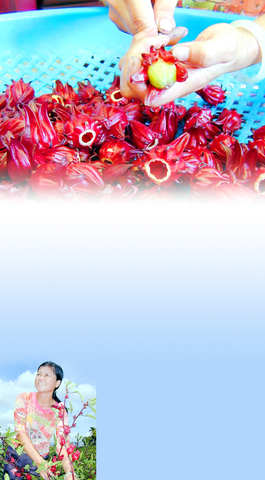The roselle, or hibiscus flower (洛神花), can be found in areas of high elevation in Asia. Here in Taiwan it is found in mountainous areas around Taitung and is known as the "ruby flower." In Taitung County, in the townships of Chinfeng (金峰) and Taimali (太麻里), at the foothills of the Dawu (大武) Mountain range, the hibiscus can be seen growing in red fields, swaying in the wind under azure skies.
Chinfeng and Taimali are Taiwan's major producers of hibiscus, with the crop covering over 200 hectares and accounting for around 90 percent of the country's output. Harvest time starts in late October, attracting loads of visitors and breaking the usual quiet of these small county townships.
Hibiscus, a member of the malvaceae family, flowers once a year. It is not indigenous to Taiwan, having been introduced from Singapore by the Japanese in 1910. They are seeded every May, with the flowers blooming in late October. The plants grow to between 1m to 2m. The petals are white with a touch of light purple. If you are interested in seeing the flowers in all their beauty you will have to get up early, however, as they are only open in the early morning, closing again by 10am.

Although the flowers are white, the roselle plant is known more for its characteristic red color which comes from the calyx, the protective layer that encases the developing bud. Once the flower has died, the calyx and ovary gradually swell in size, taking on the shape that farmers have likened to a ruby.
Every year, in late fall, whole fields of hibiscus can be seen on the mountain sides around Chinfeng. Visitors come to see them for their attractive appearance, although farmers also know them as hardy plants that can grow in various environments. According to Chuo Hsin-ming (卓新明), an instructor of agricultural affairs for the Taimali Farmers' Association, the hibiscus needs hardly any looking after reaching the sapling stage. As the leaves grow densely, all the farmers need to do is plant the seeds quite close to each other. This stops the sunlight filtering through, otherwise the plants would grow out of control.
The hibiscus does, however, like to be in sunny places, at high elevation, with plentiful rainfall and good drainage. Poor drainage will cause the roots to rot and retard growth. Chinfeng township has the Dawu Mountain range, as well as the Taimali River and Chinlun River running through it, creating perfect conditions for the flower. The surrounding area and air is clean, so food products made from these plants are completely safe to eat.

PHOTOS: YANG YI-MIN, TAIPEI TIMES
Harvesting the plants can be a time-consuming activity and often farmers' wives are drafted when the time comes to pitch in. They come armed with watering cans, wearing hats tied on with scarves to keep off the sun. The first task is to cut down the stems, heavily laden with fruit. The pickers then retire with the stems to the shade of a nearby tree, where they take off the red calyces.
During the harvest season, local government officers get together with communities to organize educational events and tell visitors about the hibiscus. People get to pick it, make their own fruit preserves and take part in a number of activities to discover the cultures of the local Paiwan and Lukai tribes.
Unfortunately, this year the hibiscus crop has been battered by typhoons, delaying the season by one or two weeks.
-- Translated by Paul Cooper

Behind a car repair business on a nondescript Thai street are the cherished pets of a rising TikTok animal influencer: two lions and a 200-kilogram lion-tiger hybrid called “Big George.” Lion ownership is legal in Thailand, and Tharnuwarht Plengkemratch is an enthusiastic advocate, posting updates on his feline companions to nearly three million followers. “They’re playful and affectionate, just like dogs or cats,” he said from inside their cage complex at his home in the northern city of Chiang Mai. Thailand’s captive lion population has exploded in recent years, with nearly 500 registered in zoos, breeding farms, petting cafes and homes. Experts warn the

The unexpected collapse of the recall campaigns is being viewed through many lenses, most of them skewed and self-absorbed. The international media unsurprisingly focuses on what they perceive as the message that Taiwanese voters were sending in the failure of the mass recall, especially to China, the US and to friendly Western nations. This made some sense prior to early last month. One of the main arguments used by recall campaigners for recalling Chinese Nationalist Party (KMT) lawmakers was that they were too pro-China, and by extension not to be trusted with defending the nation. Also by extension, that argument could be

Aug. 4 to Aug. 10 When Coca-Cola finally pushed its way into Taiwan’s market in 1968, it allegedly vowed to wipe out its major domestic rival Hey Song within five years. But Hey Song, which began as a manual operation in a family cow shed in 1925, had proven its resilience, surviving numerous setbacks — including the loss of autonomy and nearly all its assets due to the Japanese colonial government’s wartime economic policy. By the 1960s, Hey Song had risen to the top of Taiwan’s beverage industry. This success was driven not only by president Chang Wen-chi’s

Last week, on the heels of the recall election that turned out so badly for Taiwan, came the news that US President Donald Trump had blocked the transit of President William Lai (賴清德) through the US on his way to Latin America. A few days later the international media reported that in June a scheduled visit by Minister of National Defense Wellington Koo (顧立雄) for high level meetings was canceled by the US after China’s President Xi Jinping (習近平) asked Trump to curb US engagement with Taiwan during a June phone call. The cancellation of Lai’s transit was a gaudy